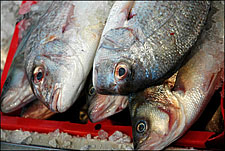Mercury
Description
Mercury, also known as quicksilver, is a naturally-occurring metal that is toxic to living organisms. Metallic or elemental mercury — an odorless, shiny, silver-white liquid — is commonly used in thermometers, barometers and fluorescent light bulbs. Metallic mercury is extremely dangerous with a few drops generating enough fumes to contaminate the air in a room. Furthermore, skin contact with the metal results in the absorption of mercury into the blood stream and potential health problems. Mercury poisoning may include the following symptoms:
- muscle weakness
- skin rashes
- mental disturbances such as mood swings and memory loss
- impairment of speech, hearing and peripheral vision
- impairment of coordinated movements such as walking or writing
- numbness and "pins and needles" feeling in the hands, feet and sometimes around the mouth
Video from the Dartmouth Superfund Research Program explains how mercury enters the seafood we eat, why eating low-mercury fish is important for good health, and the need to keep mercury out of the environment.
Download Media Player: Flashhttp://get.adobe.com/flashplayer/
 Mercury may be released naturally into the air from volcanoes and the earth’s crust, but man-made sources include the incineration of waste and coal-burning power plants. Once these industrial activities release mercury into the air, it ultimately falls back to earth, is fixed by plankton into methylmercury and is concentrated up the food chain by the fish that eat them.
Mercury may be released naturally into the air from volcanoes and the earth’s crust, but man-made sources include the incineration of waste and coal-burning power plants. Once these industrial activities release mercury into the air, it ultimately falls back to earth, is fixed by plankton into methylmercury and is concentrated up the food chain by the fish that eat them.
NIEHS, the Food and Drug Administration (FDA) and the Environmental Protection Agency (EPA) have studied the physiological effects of methylmercury, a common form of organic mercury (mercury combined with carbon), on humans via fish consumption. Although fish and shellfish have many nutritional benefits, consuming large quantities of fish increases a person’s exposure to mercury. Pregnant women who eat fish high in mercury on a regular basis run the risk of permanently damaging their developing fetuses. Children born to these mothers may exhibit motor difficulties, sensory problems and cognitive deficits.
To educate the public on mercury’s toxic affects, the FDA and EPA released a consumer advisory in 2004 that recommends that young children, women who are pregnant or who may become pregnant and nursing mothers should avoid fish that contain high levels of methylmercury, such as Shark, Swordfish, King Mackerel and Tilefish. Instead, they should eat up to 12 ounces (two average meals) a week of a variety of fish and shellfish that contain lower concentrations of methylmercury. Five of the most common "low-mercury" fish are shrimp, canned light tuna, salmon, pollock and catfish.
Health Studies & Clinical Trials
What NIEHS is Doing on Mercury
- Child Development and Environmental Toxins (633KB)
- Children's Environmental Health Center
- Comparative Genomics Group
- Environmental Exposures: Technologies for Generating Precise Measures of Environmental Exposures
- Mercury Content Reduced in Daphnia Fed High Quality Algae
- Mercury Vapor Captured from Compact Fluorescent Bulbs
- Methyl Mercury and PCB Combination Impairs Motor Skills in Young Rats
- Montefiore Medical Center: South Bronx Environmental Justice Partnership (SBEJP)
- Study Suggests U.S. Mercury Levels Are No Threat to Adult Brains
- Succimer Found Ineffective for Removing Mercury
- Superfund Research Program: Mercury
- Superfund Research Program: Metals
- University of Wisconsin Milwaukee: Marine and Freshwater Biomedical Sciences Center
General Information
- FDA and EPA Consumer Advisory: What You Need to Know About Mercury in Fish and Shellfish
- Household Products Database: Mercury
- National Toxicology Program Center for the Evaluation of Risks to Human Reproduction (CERHR): Mercury
- Talking Glossary of Genetic Terms: Mutagen
For Educators
- Healthy Homes = Healthy Kids: Mercury (188KB)
- Mercury Calculator - By typing in your weight, selecting a type of fish, and indicating the amount you might eat in a week, this tool, produced by Teachers' Domain, will calculate your estimated mercury exposure. Discussion questions are also included.

